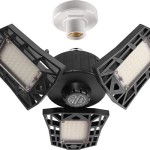Front Room Ceiling Lights: Essential Aspects to Consider
Front room ceiling lights play a pivotal role in shaping the ambiance and functionality of your living space. Here are some essential aspects to consider when selecting and incorporating these lighting fixtures into your home.
Lighting Type and Brightness
The type and brightness of your front room ceiling lights will significantly impact the overall mood and visibility within the space. Common lighting types include pendant lights, chandeliers, and recessed lights. Pendant lights tend to provide concentrated downward illumination, while chandeliers offer a more ambient and decorative glow. Recessed lights, on the other hand, integrate seamlessly into the ceiling and emit a diffused light. Choose the brightness level based on the size and functionality of your front room, ensuring sufficient illumination for both general tasks and specific activities like reading.
Size and Scale
The size and scale of your front room ceiling lights should complement the dimensions of the space. Oversized fixtures can overwhelm a small room, while undersized lights may fail to adequately illuminate a larger one. As a general rule, the diameter or width of the light fixture should not exceed half the width of the room. For high ceilings, consider pendants or chandeliers with longer drop lengths to create a dramatic effect.
Style and Material
The style and material of your front room ceiling lights can elevate the overall aesthetic of the room. From classic chandeliers made of crystal or wrought iron to modern pendants featuring sleek lines and metallic finishes, there are countless options to choose from. Match the style of the lights with the existing décor and architectural features of your home for a cohesive look. Consider materials like glass, metal, or fabric that complement the textures and colors within the space.
Functionality and Placement
In addition to providing ambient illumination, front room ceiling lights can also serve functional purposes. For instance, installing dimmer switches allows you to adjust the brightness levels to suit different activities or moods. Consider adding spotlights or track lighting to highlight specific areas, such as artwork or a reading nook. The placement of the lights is also crucial, ensuring even distribution of light throughout the room. Avoid placing lights too close to walls or furniture, as this can create shadows and glare.
Energy Efficiency and Maintenance
Energy-efficient LED or CFL bulbs can significantly reduce your energy consumption without compromising on brightness. These bulbs have a longer lifespan, minimizing the need for frequent replacements. Additionally, consider lights with built-in cleaning features, such as removable shades or dust-resistant enclosures, to simplify maintenance and keep your ceiling lights looking their best.

Living Room Lighting At Lumens

Ceiling Lights Interior For Living Rooms At Light11 Eu

Industrial Style Fireworks Led Ceiling Light For Living Room Bedroom Lightzey Thelightzey

45 Ceiling Lights Ideas For Home Office

Nordic Round Bedroom Ceiling Lamp Simple Modern Solid Wood Living Room Balcony Ultra Thin Led Lightingo Co

False Ceiling Light Options For Your Living Room Design Cafe

Nordic Light Luxury Ceiling Lamp Creative Minimalist All Copper Bedroom Lamps For Living Room Restaurant Study China Lighting Made In Com

Small Living Room Lighting Ideas Forbes Home

Lighting Tips For Every Room

Modern Ceiling Lighting Minimalist Nordic Texture Led Glass Lamp Aisle Corridor Creative Living Room Lights E27 Fruugo My
Related Posts








